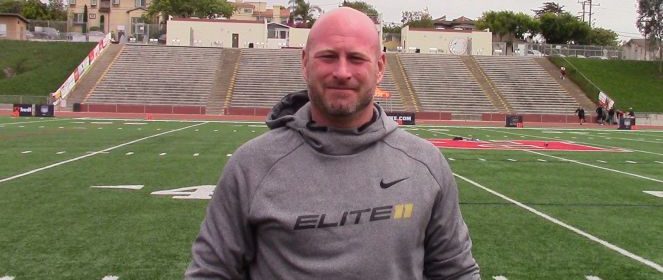In-Depth Interview with Trent Dilfer about the Elite 11 and the State of Modern Day High School Quarterbacks

Written by Ryan Wright
Twitter: @HogManInLA
On Sunday, the Elite 11 wrapped up another successful year of guiding soon to be high school seniors from regional camp action across the U.S. through the finals held in Redondo Beach (CA). Twenty-four of some of the top quarterbacks in the 2017 class went through the ringer for three days competing for a chance to make Nike’s famed The Opening Camp in Beaverton (OR).
As the players were ending action on the field, the figure head and quarterback guru for the Elite 11, Super Bowl winning quarterback Trent Dilfer, took a few minutes to reflect on this year’s event, the state of the game at the high school level in the pocket, and answered some questions on where the top talent is coming from year after year at the quarterback position.
Interview
Trent, how has the Elite 11 evolved over the years helping top quarterback prospects that come through the system improve on and off the field?
“We are trying to find ways to innovate and get a better experience for the kids. Both from a curriculum standpoint and from a bonding opportunity, training opportunity, and with tough competition. I thought this year the best thing we did – the players spent more time with each other. The way I structured pods, field work, meeting times – there was a lot more player interaction which helps build that bond, the fraternity, the closeness. I think that is a big deal. I am proud of that. I think the kids really appreciate it.”
What are some of the differences in this year’s camp as opposed to previous Elite 11 camps?
“I think from a learning standpoint, having a little more time with them on Day 1 allows to introduce more stuff over the weekend and then to be able to have more 7×7 reps and having more service players. I think you create a better evaluation opportunity for them. The feedback we have gotten back over the years, nothing negative but, “man I wish I had more 7×7 opportunities. I wish I had more night throws.” Jake Allen had 24 throws today. I think the lowest was 16 or 17. I think that was better.”
Was there a new portion to the Elite 11 camp that has not been part of the previous camps?
“I think the ability to get more tangible data on them. We’ve always known hand size, height, weight, speed, power ball, and shuttle times, but now to have the agility test that we film and the throw to arrival test which quantifies both their release time and their ball speed. We give them a test on the offensive installs and the defensive installs and the cognitive assessment test. Now we have a lot of data. The data doesn’t – we’re not data freaks. We still use a lot of balance with it but it is good information to have.
“Ultimately it is about the kids. We can do all of this stuff but ultimately it is about the kids getting better, competing well, and having a great experience. I think you should ask them but I’d be shocked if they say they didn’t.”
Has the maturation of quarterbacks playing today gotten better over the years you’ve been a part of the Elite 11?
“It’s so good in terms of throwing. It’s so good. They are such better passers than the last generation at this age. I don’t know if they are better players. I’m not a believer that modern day offenses develops quarterback play better. I think it develops better throwers. I don’t know that it develops better quarterbacks.
Was there a theme to this Elite 11 going into the finals?
“The theme of this weekend – I forget you guys (media) are not in the room for the meetings, one of the big themes was trying to help them become guys that play catch to guys that play quarterback. There is a lot to that.
“What I appreciate is having great starting point. The starting point is higher because they throw the ball so well because they play 7×7 and because they see the field 53 and one/third yards wide because of the spread offense. For those reasons you can teach them more faster but it’s still a jump that there is so much more than throwing bubble screens, getting isolation match-ups, and predetermined throws. To this group’s credit, I can’t think of one that once they saw this way said “I didn’t know this was out there.”
How big is the actual competition of the Elite 11 finals to you?
“I don’t get as caught up in the competition as people think I do. I make sure we work hard to get the 11 right but what I really care about is that the guys are getting better. Some of my best relationships are with the guys that did not make the 11 that are still using the curriculum to get better. All that being said, it is nice to have a group of guys that can really throw it, it makes our work easier.”
Is there a noticeable difference over time on where the top quarterback talent is coming out of in the U.S.?
“Atlanta – Georgia continues to every year produce studs. Texas every year produces studs and California every year produces studs. Some in the Midwest are starting to catch up. Florida has always been disappointing. We had two this year from Florida, Mac (Jones) and Jake (Allen). California, Texas, and Georgia have separated themselves. There are guys in California every year that have an argument to make it but they don’t because we can’t have seven or eight from California every year. We have had years were we took seven or eight guys from Texas. Those three area dominate.”
Trent, thanks for your time today.
“Thank you.”
On Monday, the final 12 to advance were announced (complete list of finalists). The final 12 now become part of 166 players competing to be named the best at their respective positions before their senior seasons begin at The Nike Opening.
Photo credit: recruitingnewsguru.com; Trent Dilfer at the 2016 Elite 11 finals.
